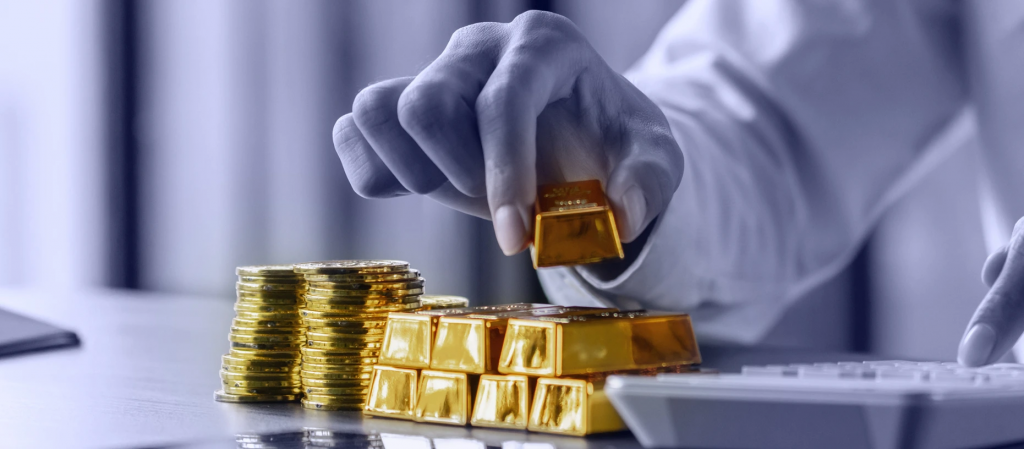Gold has fascinated civilizations for thousands of years. In modern finance, it remains one of the most debated assets. Some see gold as a safe haven, a hedge against inflation, and a store of value. Others view it as outdated and underperforming compared to stocks or real estate. Alongside gold, other precious metals like silver, platinum, and palladium also offer investment potential, but with unique characteristics.
So, is investing in gold and precious metals worth it in today’s economy? In this article, we’ll examine the role of precious metals in a diversified portfolio, their advantages and risks, and how to invest in them effectively.
Why Do People Invest in Precious Metals?
Precious metals serve several financial purposes:
- Store of Value
Gold, in particular, has maintained its purchasing power over centuries. Unlike paper currencies, it can’t be printed or devalued by central banks. - Inflation Hedge
When inflation rises and currencies lose value, gold often retains or increases its value, acting as a financial shield. - Safe Haven in Crisis
During market turbulence, geopolitical conflict, or currency instability, investors tend to flock to gold for security. - Portfolio Diversification
Precious metals generally move differently from stocks and bonds. Adding them to your portfolio can reduce overall risk and volatility.
Types of Precious Metals for Investment
1. Gold
- Most widely traded precious metal
- Valued for its rarity, liquidity, and historical importance
- Used in jewelry, electronics, and as central bank reserves

2. Silver
- More volatile than gold, but cheaper per ounce
- Industrial uses (electronics, solar panels, batteries) make it sensitive to economic cycles
3. Platinum
- Primarily used in the automotive industry (catalytic converters)
- Less common than gold or silver, but demand fluctuates with industrial trends
4. Palladium
- High demand in the auto industry, particularly for emissions control
- Prices can be more erratic due to supply constraints
Ways to Invest in Precious Metals
You can invest in precious metals through various channels, depending on your goals, risk tolerance, and liquidity needs.
1. Physical Metals
- Gold bars and coins: Typically purchased through dealers or mints. Requires secure storage and insurance.
- Silver, platinum, and palladium coins/bars: Similar to gold but often more volatile.
Pros: Tangible asset, no counterparty risk
Cons: Storage and security costs, low liquidity in emergencies, premiums on purchase
2. ETFs (Exchange-Traded Funds)
- Gold ETFs like GLD track the price of gold without requiring physical ownership.
- Silver ETFs (e.g., SLV), platinum ETFs, and palladium ETFs also exist.
Pros: Easy to trade, low fees, high liquidity
Cons: Indirect ownership, subject to fund management practices
3. Mining Stocks
- Shares of companies that mine gold, silver, or other metals
- Includes large corporations and junior mining startups
Pros: Potential for high returns when metals prices rise
Cons: Exposed to business risk, stock market volatility, and commodity pricing
4. Futures Contracts
- Speculative contracts to buy or sell metals at a future date
- Not suitable for beginners due to high leverage and risk
Pros: Potential for large profits in short timeframes
Cons: High risk, complexity, and margin requirements
5. Digital Gold and Blockchain-based Metals
- Emerging platforms allow fractional gold ownership or tokenized metal trading
- Still developing, and regulatory clarity varies by country
Benefits of Investing in Precious Metals
- Protection Against Inflation
Historically, gold has performed well during periods of high inflation or currency devaluation. - Crisis Resilience
In economic downturns or geopolitical turmoil, precious metals often hold their value better than stocks or fiat currencies. - Global Acceptance
Gold and silver are universally recognized, making them valuable in almost any market. - No Default Risk
Unlike bonds or bank deposits, gold carries no credit or counterparty risk.
Risks and Drawbacks
- No Income Generation
Precious metals do not pay dividends or interest. They rely solely on price appreciation. - Price Volatility
Silver and platinum can experience extreme price swings, especially during economic shifts. - Liquidity Issues (for physical metals)
Selling physical gold or silver quickly may incur fees, require verification, or be subject to local laws. - Storage and Insurance Costs
Holding physical metals securely can be expensive and impractical for some investors. - Opportunity Cost
During bull markets in stocks or real estate, metals often underperform.
Historical Performance
Over the long term, gold has preserved wealth, but it doesn’t always outperform other asset classes.
For example:
- Between 2000–2011, gold saw a massive bull run
- From 2011–2018, it underperformed the S&P 500 significantly
- In times of crisis (2008, 2020), gold spiked while stocks tumbled
This inconsistency highlights gold’s role more as a stabilizer, not a growth engine.

Who Should Consider Investing in Precious Metals?
Precious metals can be suitable if you are:
- Looking to hedge against inflation or currency devaluation
- Nearing retirement and want to preserve capital
- Concerned about geopolitical or market instability
- Building a diversified, long-term portfolio
They are not ideal for those seeking fast growth or passive income.
How Much Should You Invest?
Most financial advisors recommend allocating 5% to 10% of your portfolio to precious metals. This provides diversification benefits without overly exposing you to non-income-generating assets.
If you’re more conservative or preparing for uncertainty, 15% may be reasonable but going beyond that may reduce your overall returns unless metals significantly outperform.
Final Thoughts
Investing in gold and precious metals isn’t about getting rich quickly it’s about protection, preservation, and diversification. While they won’t replace stocks or real estate in a growth-focused portfolio, they do offer a historical safety net in volatile times.
If approached with a balanced strategy via ETFs, mining stocks, or physical assets precious metals can be a valuable piece of your long-term investment plan. As with any asset, the key is understanding their role, managing your expectations, and aligning them with your financial goals.
